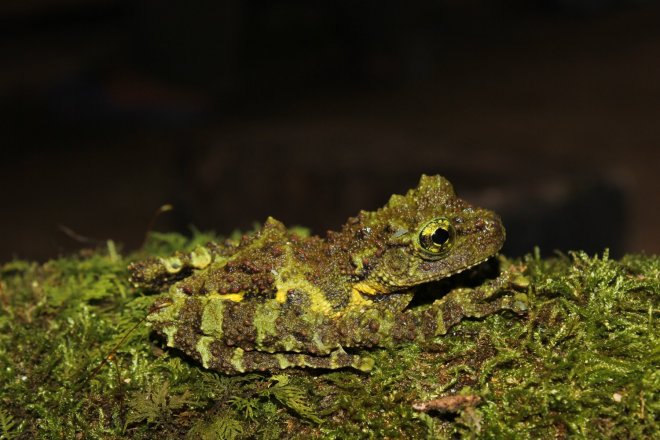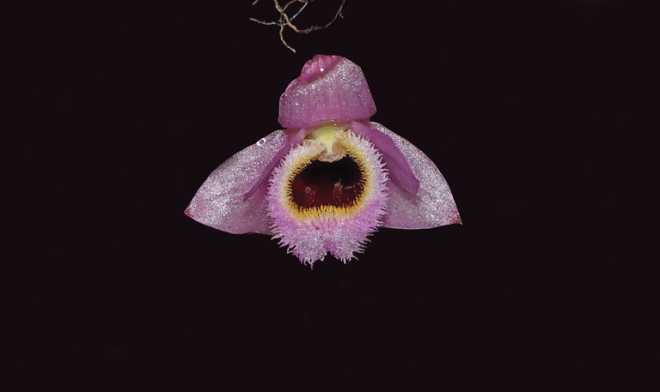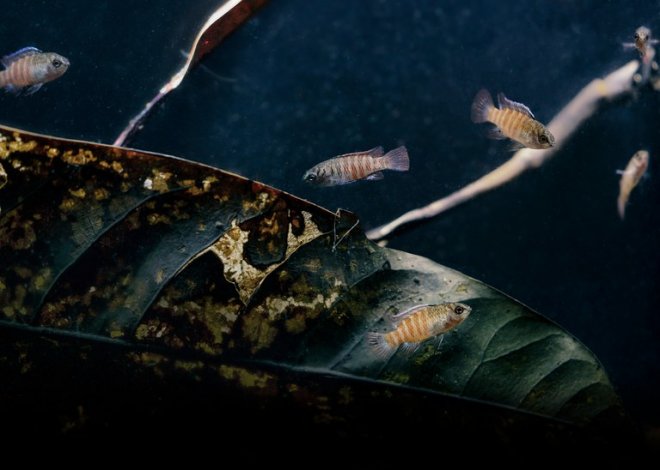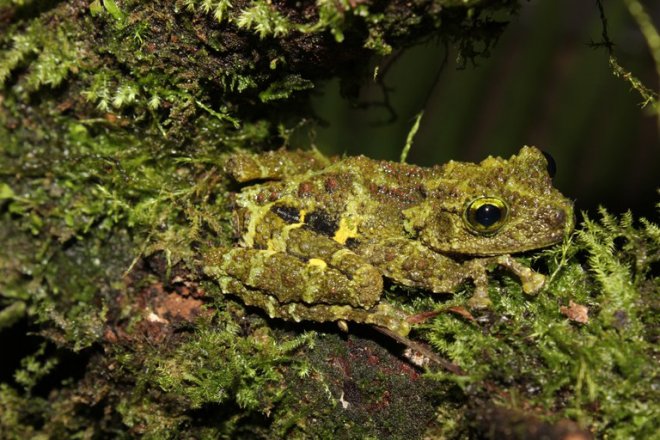
An aggressive color-changing lizard, a poisonous snake named after a goddess in Chinese mythology and an orchid that looks like a muppet among hundreds of unique species of plants and animals newly discovered in the lower Mekong region in the past two years, a new report released on Monday said.
Hundreds of scientists from across the globe discovered 175 new species in 2021 and 205 in 2022 in Cambodia, Laos, Myanmar, Thailand, and Vietnam, according to the report by the World Wildlife Fund for Nature (WWF).
“These remarkable species may be new to science, but they have survived and evolved in the Greater Mekong region for millions of years, reminding us humans that they were there a very long time before our species moved into this region,” said K. Yoganand, WWF-Greater Mekong regional wildlife lead.
“We have an obligation to do everything to stop their extinction and protect their habitats, and help their recovery.”
The newly declared species include a thick-thumbed, mouse-eared bat, whose specimen sat in a Hungarian museum for 20 years. Another one highlighted in the report is a plant collected in the 1930s but only recently confirmed to be a novel species by a new team of researchers.
Several other new species are at risk from human activities. A Cambodian casino, dam and residential development are destroying an evergreen shrub, while a Thai crocodile newt in Vietnam is threatened by agricultural encroachment, logging and local collection for medicinal purposes.
In total, they discovered 290 plants, 19 fish, 24 amphibians, 46 reptiles and one mammal in the past two years, bringing the total number of new species in the lower Mekong region to 3,389 since 1997, when WWF started collecting new species data.
The report comes on Biodiversity Day, which the United Nations promotes to increase understanding and awareness of global biodiversity issues.
According to a 2011 study, about 8.7 million species are on Earth, while only 1.6 million have been identified, meaning that more than 80 percent of species have yet to be discovered.
The wildlife conservation group also called on the governments to increase protection for rare creatures and their habitats, with many species already threatened with extinction due to human activities.
The new species are “under intense pressure from deforestation, habitat degradation, road development, loss of streams and rivers, pollution, diseases spread by human activities, competition from invasive species, and the devastating impacts of illegal wildlife trade,” WWF said.
“Sadly, many species go extinct before they are even discovered.”
A senior Vietnamese scientist said discoveries of new species help fill the knowledge gap about what exists in the natural world.
“They also fill us, the researchers, with wonder and trepidation – wonder that there are still countless species yet to be found, and trepidation that there isn’t enough time to find, understand and conserve them,” said Truong Q. Nguyen, vice director at the Institute of Ecology and Biological Resources at the Vietnam Academy of Science and Technology.
“The Greater Mekong region is recognized as a biodiversity hotspot – also known as the Indo-Burma hotspot,” Nguyen said in the report’s foreword.
The region is home to globally iconic and endangered species, including the tiger, the Asian elephant, the Sunda pangolin, and the giant freshwater stingray.
However, the region’s biodiversity is “facing tremendous pressures from economic development and human population growth, which drive deforestation, pollution and overexploitation of natural resources, compounded by the effects of climate change,” he said.
Here are some of the discovered species:
Cambodia:
Calotes goetzi, 2021
The Cambodian blue-crested agama (also known as the Siamese blue-crested lizard) is an aggressive lizard that changes color as a defensive mechanism. It is a vigorous climber and feeds primarily on insects. It was identified by studying lizards found near an Angkor archeological site. It is also found in China, Laos, Myanmar and Thailand.
 Photo credit: Henrik Bringsoe, via WWF.
Photo credit: Henrik Bringsoe, via WWF.
Cleyera bokorensis, 2021
An evergreen shrub collected first on Mount Bokor in 1933 and misidentified until it was determined to be a separate species in 2021. It is also found in Vietnam. WWF said the plant is already threatened by a casino, dam, and residential development in Cambodia and human encroachment in Vietnam. It is primarily available along bodies of flowing water in forested areas but is estimated to be less than 2,500 in each country.
 Photo credit: Shuichiro Tagane, via WWF
Photo credit: Shuichiro Tagane, via WWF
Laos:
Dendrobium fuscifaucium, 2022
A bright miniature pink and yellow orchid that resembles television character muppets, it was discovered in a market selling wild plants in capital Vientiane. Attempts to find it in the wild have been unsuccessful, according to researchers. Globally, it is estimated that 1.1 billion live orchid plants were traded mostly legally between 1996 and 2015. However, some species face threats due to trafficking and overharvesting from the wild.
 Photo credit: Keooudone Souvannakhoummane, via WWF
Photo credit: Keooudone Souvannakhoummane, via WWF
Dixonius somchanhae, 2021
Endemic to Laos, this new gecko species was discovered in a forested area near Huaysorn-Huaysua village in Vientiane. It is named after Somchanh Bounphanmy, an associate professor of the National University of Laos who supported the authors’ research. WWF said it is found at night on sandstone rocks, where they live in secondary forests affected by construction projects. It has not been seen elsewhere.
 Photo credit: Luu Quang Vinh, via WWF
Photo credit: Luu Quang Vinh, via WWF
Myanmar:
Dario tigris, 2022
A miniature chameleon fish, able to change their color, barely 20 millimeters (three-quarters of an inch) long, is recognized by its striking orange-red stripes, earning its name tiger. It was first found in the mountain streams of the Ayeyarwady River basin in northern Myanmar in 2002, but it was deemed a distinct species only last year.
 Photo credit: Thadoe Wai, via WWF-Myanmar
Photo credit: Thadoe Wai, via WWF-Myanmar
Ptyctolaemus Chindwinesis, 2021
This new lizard species is only the third species of this genus to be described, with the first being identified in 1864 and the other in 2004. It was first found in 2019 in the Htamanthi Wildlife Sanctuary, Sagaing division, and named after the Chindwin River. It is found only in Myanmar and can change its body colour.
 Photo credit: Shuo Liu, via WWF
Photo credit: Shuo Liu, via WWF
Thailand:
Ansonia karen, 2021
This new species of endemic stream toad is named for the local indigenous Karen people, who supported the researchers during field surveys. It was found in the Tennaserim mountains in western Thailand’s Ratchaburi province. It is found only in Thailand; a sister species is found in Myanmar, some 350 kilometers away.

Akysis patrator
This catfish, some of the smallest in the category, measuring less than 60 millimeters, was collected during a survey along with the Karen people in the Roh Kee River in western Thailand, which eventually flows into the Mae Klong River. It is the first fish in the Akysis genus to be recorded in the Mae Klong basin. To date, it is considered endemic to the Roh Kee River.
 Photo credit: Parinya Pawangkhanant, via WWF
Photo credit: Parinya Pawangkhanant, via WWF
Vietnam:
Theloderma khoii, 2022
This camouflaging green frog uses its mossy, irregular ridges and warts on its skin to blend into the lichen and wet dark background. It was found only in the deep narrow valleys within the forested limestone mountains of northeastern Vietnam, which has more species of mossy frogs – 17 – than any other country. It is just 5-6 centimeters long and was named in honor of Professor Le Vu Khoi from the Hanoi University of Science.
 Photo credit: Nguyen Thien Tao, via WWF
Photo credit: Nguyen Thien Tao, via WWF
Subdoluseps vietnamensis, 2021
This new skink was discovered in forested areas around acacia and rubber plantations in southern Vietnam’s Ba Ria Vung Tao and Bin Thuan provinces. It burrows under the sand to evade predators and escape from fires, hence the name Vietnamese agile skink. It was first collected in 2017 and is an endemic species with a narrow distribution in the coastal lowlands.
 Photo credit: Manh Van Le, via WWF
Photo credit: Manh Van Le, via WWF